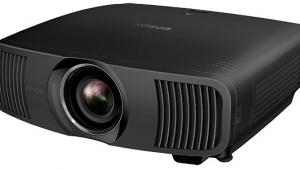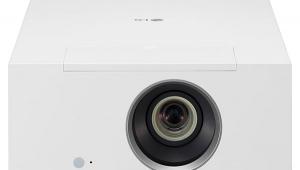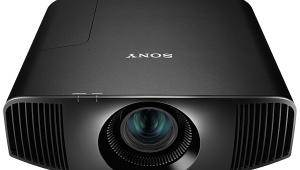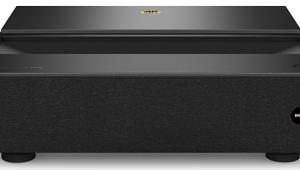ViewSonic Cine5000 DLP Projector
It is not too surprising that ViewSonic has decided to make a push into the home theater projection market. The company has a healthy lineup of business projectors and has watched other projector manufacturers successfully transition over to the HT side. But is anyone else surprised that a company known primarily for LCD TVs and monitors would go with DLP for their new line of home theater projectors? Maybe it's just me.

Late last year, ViewSonic introduced their first high-definition home theater projector, the $2,599 Cine5000. Had we reviewed this projector a few years ago, when the first crop of reasonably priced digital projectors hit the market, it would have fared quite well. But times have changed: Expectations have increased, features have evolved, and prices have fallen. ViewSonic has some catching up to do.
The Shape of Things
Like many of those first-generation digital projectors, the Cine5000 feels a lot like a business projector wrapped in a home theater shell. This is readily apparent from the moment you open the box and encounter the handsome carrying case and the "User Guide and Installation Software" CD. I don't know many people who like to travel with their home theater projectors, but the carrying case is nice just the same. ViewSonic doesn't include a hard copy of the owner's manual; you must download a PDF off the CD, which, by the way, launched OS Classic on my PowerBook. How quaint. The box does include a Quick Start Guide with basic setup instructions, laid out in about 4-point type in order to offer the text in 11 different languages.
In the world of business projectors, the image's precise size and shape may take a backseat to its brightness and visibility. But we're a bit more particular about screen size and projector placement in the home theater realm, and the Cine5000 presents a few ergonomic dilemmas—the most notable being that its lens doesn't cast a 1.78:1 image. Its shape is closer to 1.65:1, which is something to keep in mind when purchasing or building a screen. With a regular 16:9 screen, light will spill onto the frame; with broadcast HDTV content, I measured up to 1.25 inches of unused light at the top of my screen and 0.5 inches at the bottom.
Also complicating the setup is a shorter-than-average throw distance and limited 1.2X zoom. To fill my home theater's 65-inch-diagonal screen, the projector needed a distance of 104 inches, almost 2 feet farther back than my existing projector. If you want a bigger screen, you need a longer room. You can set up the Cine5000 for tabletop or ceiling and front or rear placement, and all four of the projector's feet are adjustable; however, the absence of vertical and horizontal lens-shifting features makes it difficult to perfectly position the image on the screen. You can only adjust horizontal and vertical position via the onscreen menu through the PC input.
The Cine5000 does have the desired HD inputs—HDMI, component video (only one, though), and VGA—but picture adjustments are limited. With 480i content, you can adjust brightness, contrast, color, tint, and sharpness, as well as access advanced controls for edge enhancement, gamma, and noise reduction. At 480p or higher, through both component and HDMI, you can only adjust contrast, brightness, and gamma, so it's a good thing the color and tint are fine as is. There are four picture modes (Vivid, Normal, Movie, and User), but only in the User mode can you select between High, Middle, and Warm color temperatures or adjust the global RGB settings.
Reap the Reward
The good news is, once you've set up and configured the projector, it rewards you with an attractive image. It may not be 1080p, but this 1,280-by-768 projector revealed great detail in DVD, HDTV, and HD DVD sources. Whether it was a high-def NBA game at home on my 65-inch screen or the 16 Blocks HD DVD on our lab's 100-inch-diagonal DaLite screen, I saw plenty of information in both facial close-ups and background details.
 Out of the box, the projector measures a little too cool in the Middle color-temperature mode and a little too warm in the Warm mode, but both track fairly evenly across the board; it's up to you to decide if you prefer an image that's slightly blue or slightly red. As you can see in our measurements box, we were able to improve the numbers by adjusting the global RGB controls. The Cine5000 uses a six-segment color wheel, and its color points measure fairly close to SMPTE standards, which is better than many of the budget projectors that have passed through our doors lately. Skintones looked natural, and colors were vibrant, although they lacked the richness that characterizes a truly high-end image.
Out of the box, the projector measures a little too cool in the Middle color-temperature mode and a little too warm in the Warm mode, but both track fairly evenly across the board; it's up to you to decide if you prefer an image that's slightly blue or slightly red. As you can see in our measurements box, we were able to improve the numbers by adjusting the global RGB controls. The Cine5000 uses a six-segment color wheel, and its color points measure fairly close to SMPTE standards, which is better than many of the budget projectors that have passed through our doors lately. Skintones looked natural, and colors were vibrant, although they lacked the richness that characterizes a truly high-end image.
Perhaps the Cine5000's strongest asset is its light output. By the numbers, this is a respectably bright projector, even at the darker Eco lamp setting, but both video editor Geoffrey Morrison and I commented that it seems even brighter than it measures, without having to use a dynamic picture mode that looks brighter but sacrifices color accuracy. I use a projector as my primary living-room display and have come to accept that content looks washed out on my matte-white screen during the day. While I wouldn't throw open my blinds or pop a dark film into the DVD player, the Cine5000 rendered bright, well-saturated HDTV content during daylight hours, in the most accurate User picture mode, and especially with sporting events.
Even with TI's DarkChip2, the Cine5000's black level in Eco mode measures 0.013 foot-lamberts, which is better than most flat panels but only average for a projector. This limits the overall contrast ratio to 1,276:1, so the image doesn't reach out and grab you the way a higher-end projector can. The Cine5000 still looks quite good in a darkened room, and the black detail in my demo scenes from Chicago, Ladder 49, and The Bourne Supremacy was excellent. The first evening I cued up this projector at home, my husband commented several times on how deep the blacks looked; of course, we've spent a lot of time with LCD flat panels lately. Try finding a 65-inch LCD panel that offers good color, detail, and blacks for $2,599.
The Cine5000 doesn't have outstanding bit depth, so there is some digital noise in colors and especially grays. In chapter 10 of Ladder 49, as Jack rescues a child in a smoke-filled room, the smoke often looked more like pixels than smoke. ViewSonic has chosen Faroudja's DCDi chip for scaling and deinterlacing. The projector deinterlaces 1080i correctly but doesn't pick up the 3:2 sequence with 1080i content. With 480i, it picks up the 3:2 sequence fairly quickly; I noticed some shimmer in my Gladiator test scene but no major jaggies. Unfortunately, my review sample had a serious problem with 480i content through the component video input. With three different DVD players, the projector created excessive noise in low-level test signals and other dark content, and, at times, I could see the silhouette of a 4:3 sidebar in blacks. Plus, the projector wouldn't display 480i content from my HD cable box. If you plan to use component video, you definitely need to mate the Cine5000 with devices that output 480p or higher.
The remote lacks backlighting but has plenty of useful buttons, including dedicated source buttons. The projector's fan is fairly noisy, and it never fully powers down in standby mode. If you want to silence the projector completely, you have to physically turn it off, which again hints at its business origins. In the home theater world, we prefer to leave our projectors in standby mode.
Overall, the Cine5000 offers good performance for a good price. The problem is, other projectors offer good performance in a more home-theater-friendly package for an equal if not better price. Given the current state of the industry, where you can find $999 720p projectors and $5,000 1080p projectors, it's hard to recommend a $2,599 720p projector with obvious ergonomic drawbacks and limited features, although it is worth a look if you need a projector that can accommodate a lot of daytime viewing. If anything, ViewSonic has proven with the Cine5000 that they take picture quality seriously. Once they catch up with the pack in other respects, they could be a contender.
Highlights
• Good brightness for daytime viewing
• Good color and detail
• Ergonomic issues make setup difficult
- Log in or register to post comments























































